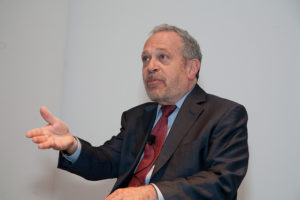Will U.S. Economic Boom Complicate Curbing Immigration?
With the number of jobs available exceeding the number of Americans seeking jobs, employers are looking beyond the border to fill openings.WASHINGTON — One of President Trump’s priorities, low unemployment, is complicating another: curbing immigration.
With the number of jobs available exceeding the number of Americans seeking jobs, employers are looking beyond the border to fill openings, and migrants are coming to the country in search of work.
Hotel and restaurant owner Todd Callewaert is short more than two dozen workers this season for his Mackinac Island, Michigan, businesses. “You can’t hire a line cook right now, it’s impossible, even for 20 bucks an hour,” he said. “We usually fill the gap with visa workers, but we can’t even get those this year.”
The Labor Department said Friday the unemployment rate was 3.9 percent, near the 18-year low set in May, and employers are adding jobs at a faster pace than last year.
Trump has made clear employers should be trying to attract American workers through wage increases and other incentives, not filling jobs with immigrants.
“Curbing immigration is essential to growing wages and ensuring available jobs go to American workers, not foreign workers,” Deputy White House Press Secretary Hogan Gidley told AP. “As immigration curbs are put into place, more and more Americans will be absorbed back into the workforce, especially those who have been left out due to poor work history or difficult life circumstances.”
The administration has made it harder to come to the U.S. for work, legally or otherwise. Work visas are costly, complicated and limited. Large-scale, job-seeking migration through a porous border is long gone.
This summer, the administration tried to deter would-be immigrants by adopting a “zero-tolerance” policy, prosecuting anyone caught crossing the border illegally. It resulted in nearly 3,000 children separated from their parents at the border, prompting international outrage. Trump eventually stopped the separations and the government was forced by a judge to reunify families.
Still, tens of thousands of people cross the border illegally every month, many seeking asylum from violence. But often, they’re coming because of the prospect of work.
Dala Edilson Ba Juc traveled with his 12-year-old daughter from Guatemala to the U.S. — only to be separated from her at the border, reunited and deported home. Sitting at an immigration facility in Guatemala City, he said they came for work.
“I needed to try to make a better life for my family — I wanted them to have what I could not give them here,” he said. “There are many, many jobs in the States.”
Frandy Frauville, 35, joined a wave of Haitians who came to Tijuana, Mexico, from Brazil starting in 2016. Brazil welcomed Haitians after Haiti’s 2010 earthquake. But Frauville grew tired of factory jobs in Mexico that barely allowed him to cover rent and food, and, lured by the prospects of better work and joining family near Miami, he lined up with his 5-year-old daughter at a border crossing.
“I’ll take whatever I can get,” he said.
And Rolando Antonio Bueso Castillo, who was separated from his infant Johan, was making only $10 a day driving a bus in Honduras. He was captured and quickly deported while his baby remained behind for five months.
He said he made the difficult journey because his brother had secured him a job in Maryland. Someday, he said, his son will ask what happened, and why he had left him in the United States.
“I’ll tell him the truth,” he said. “We thought we had a good plan to give him a better life.”
Many economists say immigration is actually good for the economy and migrants provide complementary work to the jobs Americans do. Despite Trump’s push, some business owners say they just can’t get Americans to fill the jobs.
A.J. Erskine is vice president of Cowart Seafood Group, which includes a Virginia oyster company of about 75 employees. “Entry-level is $12.13 an hour,” he said. “I don’t know how much higher we can go without being unable to sell oysters. He said the company has been in business more than a half-century, and that despite massive recruiting efforts, it can’t keep American workers.
“We just don’t have people who want to come out and shuck oysters at 3 in the morning — and I don’t blame them,” he said.
Some, like Erksine, are willing to front the cost associated with a temporary work visa, about $4,000 per employee for workers holding down seasonal, non-agricultural jobs. But the visas are capped at 66,000 annually, with 15,000 additional visas this year.
Economists say the hiring crunch could be eased in part by increasing the number of visas available during boom years, and decreasing them when the economy is weaker. But those changes must be made by Congress.
Those turning a blind eye to immigration status, or hiring people with false identification face crackdowns by immigration agents. Agents raided an Ohio garden center in the summer, arresting 114 workers and accusing the business of unlawful employment of aliens and fraud.
“It’s not worth the risk for us to hire people we’re not sure about,” said Callewaert, the hotel and restaurant owner. But a lack of staff means the business can’t grow, he said.
Rep. Dave Brat, R-Virginia., a member of the conservative House Freedom Caucus, said he did not think the lower unemployment rate would weaken efforts to restrict illegal immigration.
“The irony is it makes it more transparent what the real problem of the labor market is,” Brat said, citing about 10 million Americans not in the labor force. He called for improved education and imposing work requirements on food stamp recipients to get more of these Americans in the workforce.
“The answer is not to bring in 10 million folks from abroad,” Brat said.
___
Associated Press writers Alan Fram in Washington; Julie Watson in San Pedro Sula, Honduras; and Elliot Spagat in Tijuana, Mexico, contributed to this report.
Your support matters…Independent journalism is under threat and overshadowed by heavily funded mainstream media.
You can help level the playing field. Become a member.
Your tax-deductible contribution keeps us digging beneath the headlines to give you thought-provoking, investigative reporting and analysis that unearths what's really happening- without compromise.
Give today to support our courageous, independent journalists.









You need to be a supporter to comment.
There are currently no responses to this article.
Be the first to respond.